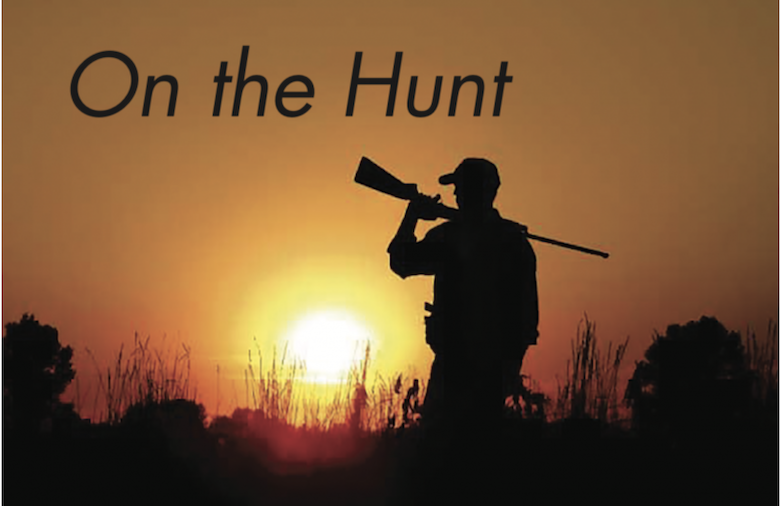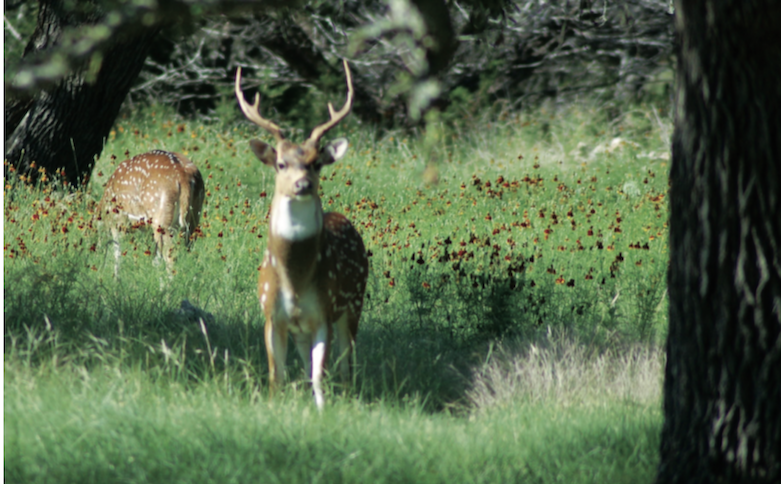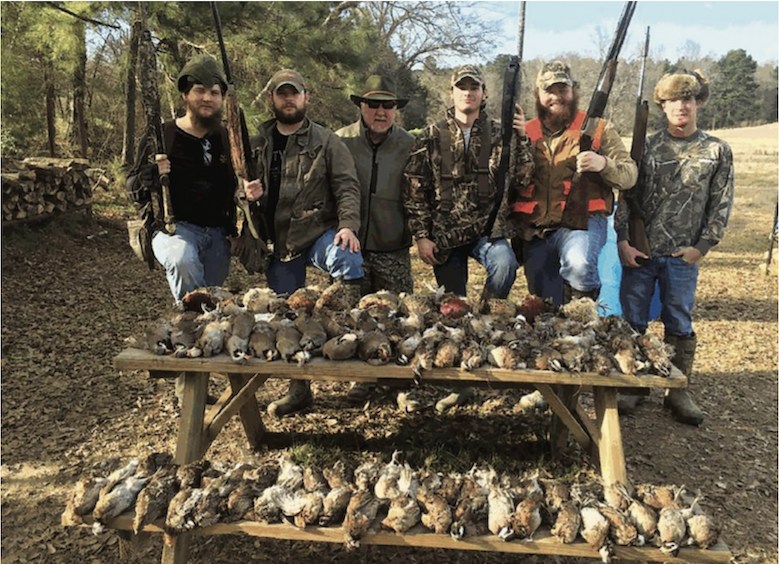By Luke Clayton
Hunters have roamed from Texas' heavily forested land in the eastern part of the state to the rugged expanses of the Trans-Pecos for thousands of years. Granted, today's hunters might not spend their afield for exactly the same reasons as those of a band of Comanche on horseback pursuing the great herds of buffalo 300 years ago, but hunting is still alive and well in the Lone Star State.
The countless herds of buffalo that roamed much of Texas until their near extinction in the mid-1800s were the primary source of food, clothing, and lodge-building material for Plains Indians who roamed the vast expanses of western Texas. From all accounts, whitetail deer across the state and mule deer in the Trans-Pecos also were extremely abundant. Game birds, such as turkey, quail, and dove, were well distributed across the state, and small game and waterfowl flourished.
Tribes, such as the Comanche, Apache, Lipan, and Tonkawa, hunted in what is now Texas for hundreds of years prior to the arrival of white settlers. Even the farming tribes, such as the Caddo in eastern Texas, sent hunting parties westward each year to hunt buffalo. These hunts were said to last several weeks, and entire villages participated in not only the hunt but the preserving and drying of the meat and hides. This “time of plenty” for the first Texas hunters lasted for hundreds of years, but when the state was settled with farmsteads and ranches, subsistence hunting was even more prevalent.
It didn’t happen overnight, but game populations slowly declined as farmers and settlers hunted game animals and birds as they wished. Some species, such as the eastern turkey, vanished from the hardwood forests of East Texas, and by the early 1900s, whitetail deer were absent from much of the state, with their numbers greatly reduced in Central and South Texas.
Thanks to forward-thinking Texans a century ago, restocking programs were initiated, and game limits and laws were enacted. The results speak for themselves; native game animals and birds are flourishing today across the state.
That’s when I got to know the DIVAS, a group of women devoted to making sure women don’t need a man to go hunting or fishing.
IGNITING THE SPARK
Hunting is as much ingrained in the DNA of today’s city dweller as it was hundreds of years ago, when hunting was a necessity. Before people bought meat pre-packaged at the grocery, there was only one way to get it, and that was to hunt and kill it. The truth is that before we can enjoy a tasty steak or baked turkey, an animal has to die.
Far too many folks today have come to disassociate the act of killing (we will use the word harvest to be politically correct) with a scrumptious Thanksgiving meal of turkey and dressing or a nice corned beef and cabbage meal on St. Patrick’s Day.
After spending 55 years in pursuit of fish and game all over this country and several others, I have come to the conclusion that some people are born to hunt and some are not, but that spark of DNA passed down through the eons from our hunting forefathers is alive in all of us.
Very often, all it takes to ignite that spark is to be invited on that first hunting trip. Through the years, I have had the privilege of introducing a great number of people, both young and old, to the hunting lifestyle. I’ve witnessed the exuberant 12 year old take his or her first whitetail buck or wild hog, as well as mature men on their first hunt.
Age and social status matter little when it comes to enjoying time in the woods or afield in pursuit of game or birds. It’s been rightly said that the outdoors is the great equalizer. During my career as an outdoors journalist, I have hunted with celebrities as well as those who could barely scrape together the gas money for a distant hunt. If they shared this “hunting blood” and enjoyed being “out there,” their social standing was left at home or at the office.
Sport hunting by both residents and out-of-state hunters contributes a great many dollars to the state each year from licenses, tags, fuel, motels, food, and hunting-outfitter fees, not to mention the cost of keeping and maintaining a season lease.
The estimated amount of retail spending by hunters in Texas alone is just over $3.5 billion annually, and Texas leads all other states in the total dollar amount spent by hunters. With more than one million hunters purchasing licenses each year and each hunter spending an average of 18 days in pursuit of game and game birds, it’s pretty easy to see how these numbers add up.
EXOTIC GAME
Texas has become a destination for hunting exotic game animals, such as axis and fallow deer, nilgai and blackbuck antelope, aoudad sheep, and many other animals, some of which are more numerous in Texas now than in their country of origin. The Edwards Plateau region is home to a large number of free-ranging exotics, the axis deer and blackbuck antelope being the most numerous.
A good friend who has a large hunting lease near Campwood in Real County says there are as many exotics as native game animals, such as deer and turkey. The vast ranch even has a well-established herd of elk, which no doubt began with a few animals that broke out of nearby game ranches.
It’s said that stocking exotic game animals began in 1930 on King Ranch in South Texas when a few nilgai antelope were purchased from a traveling circus. The antelope flourished on the vast ranch, and now hunters come from across the country to hunt them, usually after the close of traditional hunting seasons.
In the early 1950s, Charlie Schreiner III began importing and stocking exotics on the family’s vast YO Ranch in Kerr County. The animals survived and thrived in the Edwards Plateau, and today, it’s impossible to drive far down a rural road in the Hill Country without seeing high fences and exotic animals.
PUBLIC & PRIVATE HUNTS
With plenty of game and birds to hunt in the Lone Star State, the next obvious question is: where to hunt them? Land in Texas is more than 95 percent privately owned, but for those who might not wish to secure a season hunting lease on a private ranch or farm, there are options.
Since 1987, the Texas Parks & Wildlife Department’s Annual Public Hunting (APH) Permit has offered the opportunity to participate in a variety of inexpensive, family-oriented, outdoor recreational activities, including hunting for a multitude of wildlife species, fishing, nature watching, camping, and other activities.
The APH program, which includes more than one million acres throughout Texas, offers information on property owned by the TPWD, as well as acreage it leases from other state and federal agencies, forest products industries, and private landowners. The $48 APH Permit offers full privileges to hunting, fishing, camping, hiking, and the Public Dove and Small Game Hunting Areas.
Package hunts through hunting outfitters also provide opportunities to hunt everything from quail to whitetail deer. As Texas becomes more urban and hunters have less time to spend on a season lease, filling game feeders and working on cabins, package hunts with outfitters have become very popular.
Prices for these hunts range from a few hundred dollars for a wild hog hunt to many thousands of dollars to harvest a trophy whitetail buck. Some hunts are all inclusive, with meals, lodging, and guide services furnished. Some will even take care of the game meat and trophy after the hunt. Other outfitters provide hunts for more seasoned hunters, with only the hunting land, and possibly a cabin, furnished.
Every region in Texas offers myriad hunting opportunities. Let’s begin out West.
TRANS-PECOS
Ranches in the rugged Trans-Pecos often encompass many “sections” (640 acres is one section). While hunting desert mule deer on a ranch between Fort Stockton and Marathon, I drove 18 miles from the highway down the ranch road to reach the main camp. This is big country, and some of it is still plenty wild.
Game, such as whitetail and mule deer, javelina, turkey, and quail are plentiful, and some of the ranches have free-ranging herds of elk that are not regulated by TPWD. But, don’t think you can just go out and hunt elk any time you wish. The ranch owners closely monitor their elk herds, and hunters pay big bucks to harvest some gigantic bulls each fall.
EDWARDS PLATEAU
The Hill Country is home to the largest and most diverse herd of big game animals, both native and exotic, found anywhere in the United States. Whether your goal is a trophy whitetail buck or a scimitar horned oryx or maybe a free-ranging axis or blackbuck, you can find myriad hunting opportunities in the Hill Country.
Because season leases have become difficult to find and are rather pricey, two- and three-day hunts are very popular. Many hunters these days favor shorter hunts and even “package hunts,” because they don’t have the time to travel to and from a lease or the time to maintain the land and a camp house.
On package hunts with an outfitter, everything is taken care of, so the time the hunter spends on the ranch is spent hunting. Ranches that offer these shorter, all-inclusive hunts can be found throughout the state, but they originated in the Hill Country, and that’s where they are most common.
THE PANHANDLE
The wide-open country of the Texas Panhandle is not all barren, open country; much of it is traversed by wooded creek bottoms that provide hunting opportunities for some of the biggest whitetail deer in the state. Rocky Mountain mule deer, which are larger in body than the desert mule deer of the Trans-Pecos region, are also present, especially in the far western counties. These deer migrated from New Mexico and have become well established in the border counties.
Pronghorn antelope are plentiful in the region, as well. The closer one gets to the New Mexico border, the more antelope you’ll see.
Waterfowl hunting has always been good here. Because of the many playa lakes and thousands of acres devoted to growing grain, the Panhandle has become a destination for waterfowlers from across the country. Migrating sandhill crane, geese, and ducks are plentiful in many counties where they spend the winter feeding on spilled corn and other grains left over from the fall harvest.
The vast farms between Dumas and Dalhart and New Mexico provide some of the best pheasant hunting this side of South Dakota. The Sandhill region of the upper Panhandle is also home to plenty of bob white quail and pheasant.
EAST TEXAS
The forests of East Texas provide a great many hunting opportunities for both big and small game. Squirrel hunting, although not as popular is it was several decades ago, provides great sport and excellent eating for hunters with the skill and patience required to harvest a limit of “bushytails.” Cat or gray squirrels can be found along the drainages, but fox squirrels prefer higher elevations.
Wild hogs aren’t classified as a game animal, but they are plentiful across much of the state and especially along the major river systems in eastern Texas. Hog hunting and trapping has become very popular during the past several decades in Texas, and there is no better place to hunt them than along the river bottoms of East Texas.
Whitetail deer are well dispersed in East Texas and provide hunting opportunities and quality meat.
Eastern turkey have been reintroduced to many counties in East Texas, and counties such as Red River, Lamar, and Bowie along the Red River hold good numbers of these elusive turkeys of the woodlands.
Black bear, a protected species in Texas, have migrated into Northeast Texas counties along the Red River. Within the past decade, hunters’ trail cameras have captured images of bears raiding corn feeders. Biologists say these are mostly young males traveling out of their home range in Oklahoma looking for mates.
SOUTH TEXAS
The brush country of South Texas is a destination for trophy whitetail deer hunters across the globe. Nutrients in the soil in this part of the state are known for producing big bucks. Ranchers in the area now help Mother Nature get the job done by supplemental feeding with highprotein feeds and very selective harvest.
Quail have rebounded nicely in South Texas from some very low numbers of the past decade, and white-winged doves that used to nest mostly in northern Mexico now have moved farther north into South Texas counties. Dove hunting in some areas of South Texas is as good as hunting in Mexico.
Javelina (collared peccary) are numerous on many South Texas ranches and provide great hunting. Contrary to popular belief, the younger animals make excellent table fare.
Turkey numbers are very good on many ranches and provide a bonus to a fall deer hunt. They also offer exciting spring hunting during the breeding season, when they are “coming to the call.”
Texas has the most diverse terrain and abundant hunting opportunities of any state in the country. From bob white quail to alligators, Texas has it all. In hunter’s lingo, “come get you some!”
— By Luke Clayton. Outdoors writer, radio host, and book author Luke Clayton grew up hunting and fishing in rural Northeast Texas.




